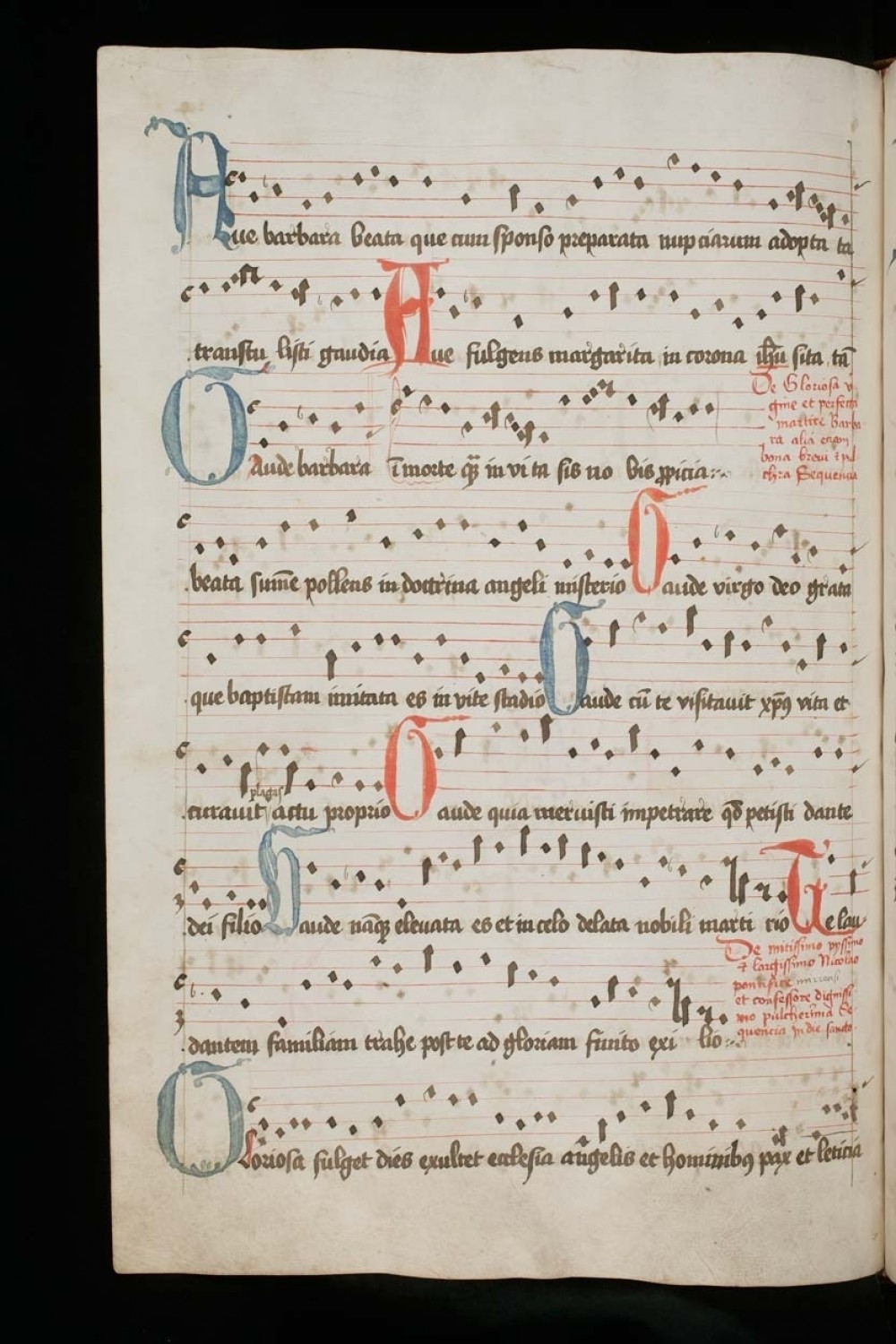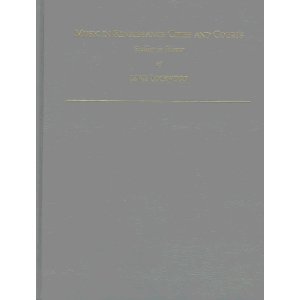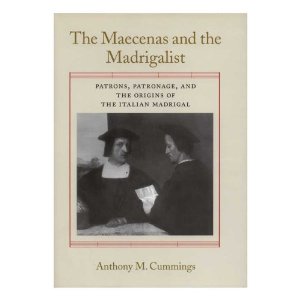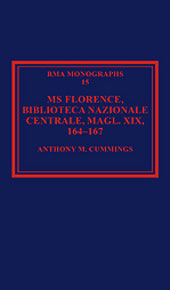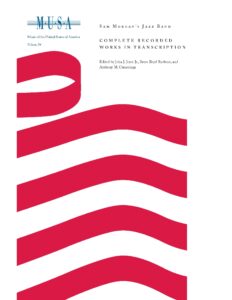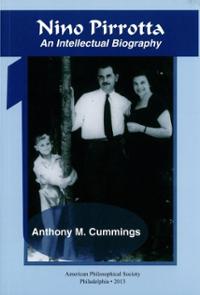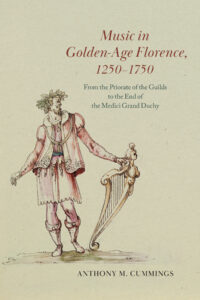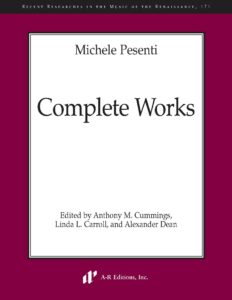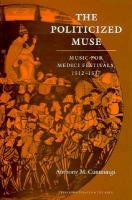 The Politicized Muse: Music for Medici Festivals, 1512-1537, Princeton Essays on the Arts (Princeton, N.J.: Princeton University Press, 1992)
The Politicized Muse: Music for Medici Festivals, 1512-1537, Princeton Essays on the Arts (Princeton, N.J.: Princeton University Press, 1992)
Reviews
“In this engagingly written book, which adopts the narrative exposition of its main sources,…Cummings has set in a rich context the often fleeting and laconic remarks of chroniclers regarding the place of music in the grand public festivities marking important political occasions….This is cultural history of the best kind;…it will have broad appeal to all students of the Renaissance….[A] splendid portrait of Medicean festivals.”
Bonnie J. Blackburn, Wolfson College, University of Oxford, Music and Letters
“[A] significant contribution to the cultural and social history of the period….Although Cummings draws together the available shreds of primary musical source material as well as extensive secondary literature, it is his resourceful and imaginative recourse to nonmusical sources, particularly contemporary narrative accounts, that has in fact yielded at once a broader contextual view of these events as well as a good deal of detailed information about specific performing ensembles, locations, and occasions….a richly synthetic study….beautifully written and generously illustrated….an insightful narrative….a model.”
Blake Wilson, Dickinson College, Music Library Association Notes
“While historians of Renaissance culture have increasingly recognized the central importance of its musical component, there has been no work that so satisfyingly demonstrates in this public, semipoliticized field….There is nothing comparable.”
Sir J.R. Hale, late Professor of Italian History, University College, University of London
“I read these chapters with great enthusiasm, and thirsting for more….I would describe what I have been reading as fine cultural history, not specifically or even in the first instance useful to musicologists, but to all of us….This wide appeal rests upon its broad base in primary sources; it reflects the reality of primary sources, which is that as you find them,…they…are of potential interest to us all, and if you allow the character of this material to shape the eventual history you write, that universal appeal survives.”
John Shearman, late Charles Adams University Professor, Harvard University
“[T]his synthesis…into a readable account that elucidates the content for the works of art generated by these festive events is indeed original….Cummings makes original and effective use of iconographical and interdisciplinary sources….Cummings meticulously recounts every aspect of festivals involving music….Everything is profusely documented…Framing the narrative chapters are an introduction…and a conclusion that is a virtuosic attempt to summarize and classify the types of music accompanying the festivals.”
Barbara R. Hanning, City College and the Graduate Center, City University of New York, American Historical Review
“reconstructs the festivals…with rich contextual detail.”
The Idler
“The author attempts to do justice to the multiplicity of offerings…by not dissolving the music played at the festivities from their surroundings, but rather considers them in their whole political and artistic context….Cummings, with overwhelming wealth of detail, attempts to reconstruct faithfully all the artistic activities surrounding such an event as it happened….The Florentine Carnival of 1513….is rendered especially vividly: in general it is extraordinarily well documented….The wealth of sensual stimuli with which the festivals of the Renaissance cast a spell over their participants can be traced especially well in this example through well-selected pictorial material and musical examples….After a broadly based cultural-historical look at the festival culture of the Medici, the author, in the short concluding observation, returns the focus more strongly to purely musical matters. He offers a very instructive classification scheme.”
Andrea Lindmayr, Die Musikforschung
“Cummings concentrates his attention, rather than on the musical works in themselves, on the circumstances that determined their origins and even more on the context and the means by which the performances took place, offering convincing reasons for, and attributing acute importance to, the musical choices, against the political background of the restoration of Medici power.”
Arnaldo Morelli, Università degli studi dell’Aquila, Recercare
“A good example of ‘cross-disciplinary’ history.”
Manuela Morresi, Rivista storica del Lazio
“The book’s aim…is ingeniously achieved drawing from ‘narrative’ accounts whose importance is well argued in the Introduction….[I]t should be useful reading for anyone wishing to assess how music contributed to everyone’s and everyday life.”
Nino Pirrotta, late Walter W. Naumburg ’89 Professor of Music, Harvard University, and Professor of Music History, Università degli studi di Roma, «La Sapienza»
 with William G. Bowen, et al., University Libraries and Scholarly Communication: A Study Prepared for the Andrew W. Mellon Foundation (Washington, D.C.: The Association of Research Libraries, 1993)
with William G. Bowen, et al., University Libraries and Scholarly Communication: A Study Prepared for the Andrew W. Mellon Foundation (Washington, D.C.: The Association of Research Libraries, 1993)
“an impressive survey of the development, present state, and future potential of learning, its accumulation and dissemination.”
Nicolas Barker, Emeritus Head of Conservation at the British Library and Fellow of the British Academy, The Times Literary Supplement
“a work that should be of substantial interest to librarians and academic administrators in all types of institutions as a cogent and tempered description of many of the issues confronting academic communities today….a valuable articulation of the challenges faced daily on most campuses….This volume is highly recommended for inclusion in every academic library….This report may serve as a benchmark in years to come as a pivotal study,…as it attempts to put into some historical perspective the state of research libraries today.”
Carol A. Hughes, The Research Libraries Group, The Library Quarterly
co-edited with Jessie Ann Owens, Music in Renaissance Cities and Courts: Studies in Honor of Lewis Lockwood (Warren, Mich.: Harmonie Park Press, 1996)
“a most impressive volume….The list of…authors reads like a who’s who of American Renaissance music history….The volume is beautifully produced…, and the quality of its contributions is consistently high….[T]his collection represents the most up-to-date work in a whole variety of areas….For new graduate students there could hardly be a better place to get an overview of the best recent scholarship. The editors are to be congratulated on a fine tribute to a worthy recipient.”
Noel O’Regan, University of Edinburgh, Music Library Association Notes
<>
<>
The Maecenas and the Madrigalist: Patrons, Patronage, and the Origins of the Italian Madrigal, Memoirs of the American Philosophical Society Held at Philadelphia for Promoting Useful Knowledge CCLIII (Philadelphia, Penn.: The American Philosophical Society, 2004) [publication supported by a Lila Acheson Wallace/Reader’s Digest Publications Subsidy from Villa I Tatti, The Harvard University Center for Italian Renaissance Studies, Florence]
“The scholarship is sound, well documented, and up to date. One of the strengths of the book is the breadth of its coverage. The material will be of interest to scholars in all areas of Florentine Renaissance studies. The author’s comprehensive organization of the material and the conclusions he draws from it, and his ideas about the role of Medici patronage of the early madrigal, are original and important. The book is richly illustrated with both visual materials and musical examples. A wonderful contribution.”
Ruth I. DeFord, Hunter College and the Graduate Center, City University of New York
“an in-depth, scholarly history of the madrigal….[O]riginal and academically invaluable…contribution to the study[,] which is most especially recommended.”
Library Bookwatch: An Official Newsletter of The Midwest Book Review
“an important book that contributes not only to the history of music but also to the history of Florence and to Renaissance cultural history….The work’s setting is Florence in the first decades of the sixteenth century,…before the final installation of a Medici duke in 1530….Who…supported music in Renaissance Florence before that final political transition, and how did the madrigal develop there?…Cummings has waded into…relatively uncharted waters to distinguish some of the major groups, their members, and their social networks….Cummings argues convincingly that in order to understand this era and its great cultural creativity, one needs to understand and follow these social organizations and networks. Informal, literate, and competitive, these groups and their performances provided fertile ground for innovation. Cummings’s study is a most valuable contribution not only to the history of music but also to Florentine and Italian history of the era more generally.”
Ann E. Moyer, University of Pennsylvania, American Historical Review
“…[C]hapter 4 presents a well-organized account of the Medici as patrons of the early madrigalists. Cummings draws on a wide array of evidence to construct a synthesis that vividly depicts the world of the Florentine cultural elite around 1520 and their contacts with composers who created the early madrigal. This impressive study offers a valuable perspective on social and musical phenomena that proved decisive for the development of the most important and influential genre of secular music in the sixteenth century.”
Patrick Macey, Eastman School of Music, University of Rochester, Renaissance Quarterly
“…expert and readable….We learn of new kinds of patrons and a great deal about the music created to please them in Renaissance Florence….This is a major contribution in a delightful…field of music history.”
Bibliothèque d’Humanisme et Renaissance: Travaux et Documents LXVIII (Geneva: Librairie Droz for the Association d’Humanisme et Renaissance, 2006
“With this volume Cummings makes a solid addition to literature on the origins of the madrigal (e.g., work by Martha Feldman, Iain Fenlon and James Haar, et al.). Cummings asserts that the relatively informal societies, academies, and convivial ‘companies’ active in Florence during the 1510s provided a flexible, experimental performance environment, one in which several early cinquecento madrigalists (including Pisano and Verdelot) found an important source of patronage. He also concludes that the Medici had a more profound impact on the origins of the madrigal than has been generally accepted. The book comprises four chapters: ‘The Orti Oricellari,’ ‘The Sacred Academy of the Medici,’ ‘The Companies of the Paiuolo, Cazzuola, Broncone, and Diamante,’ and ‘Medici Mecanatismo and the Early Madrigal’ (which includes discussion of the overlapping membership in these organizations and the web of early cinquecento Florentine culture, politics, and music patronage). The chapters are framed by an introductory essay (on recent research into the field and also including an explanation of Cummings’ goals) and a brief closing section addressing the author’s main conclusions….Highly recommended.”
Dane O. Heuchemer, Professor of Music, Kenyon College
<>
<>
MS Florence, Biblioteca Nazionale Centrale, Magl. XIX, 164-167, Royal Musical Association Monographs XV (Aldershot, Hants: Ashgate Publishing Limited, for the Royal Musical Association, 2006)
“This monograph is an extremely interesting and important source on Florence, Biblioteca Nazionale Centrale, Magl. XIX, 164-167.”
Libreria Ledi
“The book starts with a detailed discussion of the manuscript as a physical object, then uses study of concordances and broader cultural history to place it in its milieu. It is a model study, old-fashioned codicological work leading out into more fashionable contextual matters….[A] good piece of work, which should…be shelved alongside the facsimile.”
Early Music Review CXVIII (April 2007)
<>
<>
<>
The Lion’s Ear: Pope Leo X, the Renaissance Papacy, and Music (Ann Arbor, Mich.: The Univ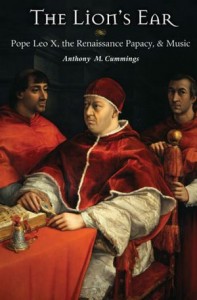 ersity of Michigan Press, 2012; 2022 [paperback edition])
ersity of Michigan Press, 2012; 2022 [paperback edition])
“Cummings has produced a masterful synthesis of material from a variety of disciplines to give a striking portrait of music and music making in the Rome of Leo X, a portrait that goes far beyond other studies in its detail and careful consideration of the actual venues where the music making took place. Drawing on a vast trove of documentary materials and alive to the latest theories of historians and art historians, Cummings’s book draws us into the sound world of Rome in the 16th century, allowing us to imagine the music that followed Leo wherever he went,…Written in an engaging style, the book speaks to specialists and nonspecialists and to anyone…interested in the place of music in one of the most brilliant periods in the history of Western civilization.”
Richard J. Sherr, Caroline L. Wall ’27 Professor of Music, Smith College
“As pope, Leo X was one of the most extravagant, using his extensive connections in the arts to lavish his court with some of the most opulent feasts and festivals of his time. Many well-known composers, performers, and artists were welcomed into Rome during his pontificate, and this book documents many of those encounters, concerts, and ceremonies. To support the documentation, Cummings (Lafayette College) provides many woodprints, color plates, photographs, musical scores, and artworks. The book is geared toward Pope Leo X’s musical contributions during his reign, but the interdisciplinary background the author provides and his extensive illustrations serve to elucidate many of the interconnections that took place among the arts in Rome during this time period. An excellent overall presentation of this historical figure and his effect on the arts during the transitional period of the early Reformation.”
B.L. Eden (Valparaiso University), CHOICE: Current Reviews for Academic
Libraries (October 2012)
“It is well known that Leo loved music, played instruments and may have composed himself, and that music more generally played a vital role in the public and private festivities of which he was so fond; however, as Anthony M. Cummings points out, this is the first monograph dedicated exclusively to the musical culture under his reign. Reasonably, the author’s approach, given the way in which music is integrated into courtly activities, is not narrowly confined to compositions and composers, nor does it aspire to add to the copious existing archival research….[R]ather, it addresses how and where music happened (or might have happened), who was involved in it, who would have heard it and what role it had in various contexts….Cummings draws comprehensively on the published sources and the secondary literature….[A] vivid picture emerges regarding the wide variety of spaces where music undoubtedly happened (and what kinds of music happened there), up to and including the ancient Roman baths and the pope’s hunting lodge at La Magliana. The author…argues convincingly that the music would have been of a similar type and sound….[A]n informative and comprehensive picture of musical practices in and around the papal court emerges….[A] book which was waiting to be written, and…a useful point of reference for scholars of several disciplines studying the Renaissance papacy.”
Thomas Schmidt-Beste, Early Music
<>
<>
<>
<>
ed. with John J. Joyce Jr. and Bruce Boyd Raeburn, Sam Morgan’s Jazz Band, Complete Recorded Works in Transcription, Music of the United States of America XXIV, Recent Researches in American Music LXXIII (Middleton, Wisc.: Published for the American Musicological Society by A-R Editions, Inc., © 2012)
“This transcription of the complete recorded works of Sam Morgan’s Jazz Band is a model of how the musicological tradition of scholarly critical editions might be applied to jazz….As Anthony Cummings notes in his preface, the Morgan volume constitutes a major addition to a very small body of such publications:…Disparaging comments about transcription are a recurring trope in the jazz literature: the subtleties of jazz performance cannot be captured by conventional Western notation, so the argument goes. In their contributions to the front matter, Cummings and Joyce construct a strong and eloquent case against this argument….[T]his new volume of Sam Morgan Jazz Band transcriptions offers an opportunity not only for jazz scholars to gain a deeper understanding of African American jazz as it continued in New Orleans in the 1920s, but also for educators to explore that arena, bringing the Sam Morgan transcriptions to life in concert.”
Barry Kernfeld, editor of The New Grove Dictionary of Jazz (New York: St. Martin’s Press)
<>
<>
<>
Nino Pirrotta: An Intellectual Biography, Transactions of the American Philosophical Society CIII/1 (Philadelphia, Penn.: The American Philosophical Society, 2013)
(winner of the John Frederick Lewis Award of the American Philosophical Society for the best book published by the Society in 2013)
Antonino (“Nino”) Pirrotta, 1908-98
Licenza in history of music and Diploma di magistero in organ performance and composition, Conservatory of Music, Florence, 1929
Dottore in Lettere in history of art, University of Florence, 1930
A.M., D.F.A., L.H.D., Mus.D. (Cantab.), Laurea “Ad Honorem”
Docent in the History of Music, Professor of the History of Music, and Librarian, Conservatory of Music, Palermo, 1936-48
Director of the Library, Conservatory of Music, Rome, 1948-56
Visiting Professor of Music, Princeton University, Princeton, N.J., 1954-55
Visiting Professor of Music, Columbia University, New York, N.Y., 1955
Walter W. Naumburg ’89 Professor of Music and Head of the Eda Kuhn Loeb Music Library, Harvard University, Cambridge, Mass., 1956-71
Professor of the History of Music, University of Rome, 1972-78
“Pirrotta was a visionary in his chosen field; a musicologist who expanded the parameters of the field and increased the understanding of students and colleagues. Here Cummings (music and Italian studies, Lafayette College) traces Pirrotta’s work across seven decades, focusing on his restless intellect.”
Book News Inc.
“Pirrotta was a singularly important scholar and teacher, whose insights and achievements well deserve such treatment. A very valuable contribution to modern understanding of the field of music history as practiced by one of its most gifted individuals. Its discussion of Italian art, philosophy, and pedagogy in the early 20th century are of special value. Scholars in all fields touching Italian history, from the middle ages to the nineteenth century, will find it rewarding. Cummings has devoted years of work to this book, has interviewed family members and surviving colleagues and student of Pirrotta’s, in short has done excellent work in building the portrait that is his main subject with accuracy and care. Path-breaking.”
Lewis Lockwood, Fanny Peabody Professor Emeritus of Music, Harvard University
<>
<>
<>
Music in Golden-Age Florence, 1250-1750. From the Priorate of the Guilds to the End of the Medici Grand Duchy (Chicago, Ill.: The University of Chicago Press, 2023)
“Cummings’s history of music in Florence over a five-hundred-year period is a work of brilliant synthesis, bringing together in one place a vast array of sources that few readers could otherwise hope to access, much less encompass. Music in Golden-Age Florence, 1250–1750 succeeds in its author’s goal of raising Florentine accomplishments in music to a status comparable to that enjoyed by the city’s extraordinary achievements in arts, letters, and science, and in so doing…becomes a compelling argument for why music should be integrated into interdisciplinary considerations of Florentine culture. Specialists and non-specialists alike will find this a highly readable narrative of this great city’s vibrant musical life during the medieval and early-modern periods.”
Blake Wilson, Professor Emeritus of Music, Dickinson College: https://press.uchicago.edu/ucp/books/book/chicago/M/bo183893384.html
<>
“This project was a complete success and cannot be valued highly enough….The author is…concerned with the synthesis of current interdisciplinary research results on the one hand and…a balanced presentation of local and global phenomena as well as their adequate contextualization within the music-historical narrative on the other….Only by looking at many such local music stories together does a multi-faceted overall picture emerge….In addition to the numerous illustrations and…musical examples, the…name and subject index and…extensive bibliography are particularly useful for the reader. References are…easy to look up and…not just hidden in the endnotes….The book should not only be useful for musicologists, as it also makes an important contribution to the cultural history of the city of Florence and beyond.”
Stephanie Klauk, Sehepunkte. Rezensionsjournal für die Geschichtswissenschaften XXIV/4 (2024)
<>
“If you care about one or more of trecento polyphony, Dufay, the birth of the madrigal, the birth of opera, and the invention of the piano, it can be pretty cool to be reminded of Florence’s role in all of them….Cummings’ structure…gives him the opportunity to bring to light some much less well-known repertoires (17th-century Florentine sacred music; 18th-century Florentine opera) and put them [in] conversation with the more famous musical developments of their times….[I]t does a remarkably good job of covering the bases. I learned a lot….The presentations of Florentine political history are masterfully concise,…[W]hat general-readership book could…[this book’s readers] have even gone to? I hope this book reaches a wide enough audience to get people interested in…composers [Francesco Landino, Paolo tenorista, and Jacopo da Bologna] – or in La Pellegrina, or any of the numerous more obscure figures it discusses. Cummings’ prose is clear and clearly intended to be accessible; his synoptic point of view is a refreshing change of pace for work on these repertoires.”
Jacob Reed, “Left on Reed,” Substack https://leftonreed.substack.com
<>
“This book is recommended to academics and musicologists interested in the music of this time…and place. The book is about music in Florence, Italy[,] from 1250-1750,…The…blend of historical and musicological information makes it particularly outstanding. As the title indicates, this book presents the music composed and performed in Florence during its most prolific and productive time….Divided into four major sections…and a conclusion, 500 years of historical and musical history are discussed and intertwined….The conclusion provides a concise summary of both musical and political Florence during these…years….I appreciate the level of detail provided in the musical examples and their descriptions;…I…appreciate how the author has interwoven historical information and musicological descriptions, as well as various personages and composers of importance. The numerous black-and-white images and photographs, along with the color plates,…balance…the textual and musical examples….[T]he attempt by the author is commendable in…writing for…different…audiences.”
Bradford Lee Eden, “Review,” World History Encyclopedia, 23 August 2024
<>
“As…Cummings notes in the introduction to his book covering some seven centuries of Florentine music history, there is no single book, even in Italian, addressing this topic, although numerous specialized studies (including Cummings’ own prolific works) focus on individual places or institutions. With an enormous amount of synthetic work, he has sought to remedy this lack and…fill in the transitions between political regimes (Republic and Grand-Duchy, or the…later Seicento) by highlighting first individual composers and then the institutions that supported them. The wide-ranging nineteen chapters start in the Duecento and continue until the end of Medici rule….If at first the attention is given to individual composers (e.g.[,] Francesco Landini), the later parts of the book take up his stated task of institutions, with a laudable balance between…secular and sacred spheres….One real strength of the book is its balanced treatment throughout, both in musical production across cultural divides[,]…and in its overall tone….The fifty-odd musical examples – in additions to analyses of vocal texts – are well-placed throughout the chapters, and Cummings should be praised for his special care in drawing on the work of others when venturing into areas outside his own specialty (the early Cinquecento). The examples are not encumbered by heavy or technical musical analyses,…Cummings has put enormous amount of care into this large-scale survey, and the results are evident. The production design and music examples have been carried out with clear precision (there are even color plates reproducing some of the other illustrations), and Cummings has more than done justice to the task that he set…for himself.”
Robert L. Kendrick, Department of Music, The University of Chicago, “Review,” Annali Reviews Online VII/2 (2024)
“…[A] unique book in the current musicological publishing landscape….[A] fascinating scholarly concept, surveying 500 years of music…in a single city….If Florence’s past cultural primacy is common global knowledge, its role in music history is almost a secret….While many articles, books, and musical editions shed light on virtually every corner of this history, a comprehensive narrative is only found in specialized dictionary entries aimed at a professional audience….Non-musical generalist histories primarily consist of textual narratives written in an accessible style. In the case of art history, authors discuss paintings, sculptures, and buildings. Still, in the case of Florence, they can at least expect a general familiarity with household names like Leonardo da Vinci, Michelangelo Buonarroti, and many other artists born in the city. Instead, Cummings has to contend with the reality that pre-1750 music is radically less relevant to our popular culture….This is, of course, one of the book’s attractions, which introduces readers to a largely unknown musical world….Cummings…presents the reader with a vibrant tapestry of descriptions and ideas. As in other publications, he deploys his tactile knowledge of the city, its churches, and the palazzi hosting its powerful families. This is matched by his great familiarity with Florence’s religious, civic, and private rituals across the centuries, and his vast and deep understanding of Florentine (and more general Italian) culture.
[A] generalist audience is ill-equipped to read technical discussions of centuries-old musical compositions….Cummings…has decided…to include scores and discuss music, sometimes in detail….In his introduction, Cummings reassures us by announcing an ecumenical approach….The ‘buffet’ approach allows readers to choose a mode of musical description accessible to their level of expertise.
The…‘book’…devoted to the seventeenth and early eighteenth century…is…the longest….[T]he bulk of the chapter is devoted to opera….Given the intensity and complexity of Florence’s exchanges with different operatic centres – especially Venice and Rome – it is challenging to build a consistent narrative while preserving the Florentine perspective. Yet Cummings manages…admirably…the web of influences and imports while offering a wealth of music examples that help him tangibly chronicle the evolution.
The book is beautifully produced, with colour plates and many music examples….This book’s original contribution to the field mainly consists of synthesis and contextualization. Specialists in individual historical periods will recognize the topics and, in some cases, be familiar with the scholarship. Very few control five centuries of Florentine music history as part of their research, so even they will benefit from…such a lavish ‘View of Florence.’ The intended audience…extends much beyond scholars and readers curious about early-music history. Everyone interested in Florence – and more generally in Italian history – will enjoy and profit from reading this elegant book.
Giovanni Zanovello, School of Music, Indiana University
Music & Letters (2025)
<>
<>
…[A] vast musicological literature…had never been synthesized into anything resembling a historical narrative….Anthony Cummings’s invaluable Music in Golden[-]Age Florence provides, at last, the sweeping synthesis of Florence’s musical history that I, my students, and my university craved….Cummings’s book is a stunning, monumental achievement, as its bibliography of over 500 items attests. It is at once boldly ambitious and modest. Modestly, Cummings’s introduction asserts that he means only to answer three questions about Florentine music in its most historically important half…[millennium]: (1) ‘When and where was music heard?’ (2); ‘What were the music’s defining characteristics? What distinguished Florence’s sound world at that extraordinary moment?’; and (3) ‘Why are late medieval and early modern Florentine musical accomplishments so important?’ Boldly, he attempts to answer these questions by synthesizing over a century of music historical scholarship into a chronological account of elite musical life in Florence over half a millennium. By aligning that account with, on the one hand, the standard chronological account of the city’s political history that historians of the other arts will know, and, on the other, the long-conventional ‘history of Western musical style’ still taught in American universities and schools of music, Cummings creates a narrative that can serve the needs of multiple audiences. Political historians, historians of art, dance, or theater, students at all levels who are drawn to Florentine studies, aspiring tour guides to Florence, and general readers are all likely to be grateful to Cummings for this book.
Clear organization and an uncluttered writing style signal Cummings’s interest in addressing a wide audience. Ingeniously, he organized the book into four ‘books’….Cummings tells his stories about music with the almost effortless ease of a long-practiced undergraduate teacher. He explains details of musical style well, rarely lapsing into the jargon associated with ‘music appreciation’ texts, and provides musical examples that readers literate in Western notation will find stimulating to their aural imaginations. Few musicologists are so skilled at describing rituals (ecclesiastical and secular) so as to illuminate the function of music to spiritual or political experience, or so widely read as to synthesize details gleaned from literary sources into a thoroughly music-centered narrative. And I know of no scholar who has so masterfully untangled the competing intellectual, political, and ego-driven narratives that surround Florence’s greatest gifts to the Western music tradition – the simultaneous invention, between 1585 and 1600, of a style of accompanied solo singing intended to emulate ancient Greek solo song (by Giulio Caccini, realizing the aesthetic intentions of one set of local humanists centered around scholar soldier Giovanni de’ Bardi) and that of all-sung drama intended to emulate ancient Greek drama (by Jacopo Peri, realizing the aesthetic intentions of a another set of local humanists centered around banker Jacopo Corsi). That section alone…is worth the price of the book….Music in…Golden[-]Age…Florence is an irreplaceable book that usefully introduces the history of a musical culture every bit as dazzlingly generative as its better-known visual and literary culture.
Suzanne Cusick
New York University
Journal of Modern History (2025)
<>
<>
There is no shortage of scholarly writing on…Florence, a city widely regarded as the center of the Renaissance….Yet its musical importance is less understood than its artistic, literary, architectural, economic, and political accomplishments. Anthony M. Cummings adjusts the scale…with the first monograph-length study to embrace the…five-hundred-year period he calls “The Golden Age of Florence,” spanning 1250-1750….[T]here is something novel for any reader. The book’s ambitious scope begins with the duecento emergence of laudesi confraternities and ends with the settecento cantata….[M]edievalists will find much to digest….Cummings remarkably illuminates the extant repertoire by carefully considering the…spaces in which music was performed, as well as the people and institutions involved in creating a distinctly Florentine ethos in the medieval period….Religious historians will be particularly interested to read Cummings’s account of the role…sacred Florentine musical spaces played in the emergence of a trecento polyphonic tradition….I have had multiple discussions over the years with colleagues outside of musicology who are interested in incorporating music into their scholarship but find themselves intimidated not only by the impenetrability of musical sources…but also the enormity of musicological literature surrounding Florence and its equally impenetrable jargon and examples. For any readers fitting this description,Music in Golden-Age Florence will be welcome and required reading. A further important audience should be professors seeking exceptional shorter readings for students. I am already incorporating portions of the book into my syllabi. Chapter 10, “Girolamo Savonarola and the Medici in Exile,” presents an entertaining, informative, contextually cogent account of Savonarola’s rise and fall and its impact on Florentine musical life – all in six pages. It is an impressive feat of prose for a complicated topic. Additionally of note for specialists and nonspecialists alike, an accompanying recording is available for purchase or streaming on all the usual platforms….[T]his is a fabulous addition, and I hope it represents a new trend in the field….The…strength of Music in Golden-Age Florence is the expert synthesis of a titanic array of literature. The bibliography alone is staggering and will be an invaluable resource for anyone working on Florence….Cummings…manages to introduce fresh perspectives that deepen our understanding of Florence’s musical culture….[I]n chapter 12, “A New Institution, a New Technology, a New Genre: The Italian Madrigal,” Cummings offers a correction to the presumption that the Florentine madrigal saw little innovation in the 1540s-60s after the blisteringly[-]exciting early years of its development….Cummings expands on the mediation and circulation of the mid-seicento Florentine madrigal, particularly in its performance context, to present a more nuanced picture considering the most recent scholarship on the topic. This helps complete a narrative of Florentine activity that might often leave too large a gap between Philippe Verdelot and the arrival of Alessandro Striggio. Cummings’s account considers more deeply the flow of people and musical sources in and out of Tuscany, in this case, particularly to Ferrara….[E]ven for cinquecento specialists, there are new things to discover. It is…thrilling to see a cohesive narrative include topics as disparate as early monody and Cristofori’s fortepiano. I am fascinated by Cummings’s exploration of the instrument’s development and its treble-bass polarity as an intellectual parallel to the (neo)classicist tendencies that shaped the rise of opera….Music in Golden-Age Florence is a significant contribution to the field. Cummings’s expertise and thorough research provide a comprehensive overview of Florence’s musical heritage, highlighting the city’s influential role in shaping musical genres and innovations that had a profound impact on Western music. There is still much to explore about Florence, and this work will serve as a new starting point for a generation of scholars embarking on fresh research.
Speculum, the journal of the Medieval Academy of America
<>
<>
Despite the distinguished musicological tradition on Florence’s musical culture[,]…until now no one had attempted to write a comprehensive history of music in Florence….Cummings’s volume fills precisely this lacuna by offering a remarkably[–]detailed, yet lively and enjoyable, history of music in Florence during its golden age….Drawing on the…distinguished musicological tradition as well as on scholarship from other disciplines, Cummings’s history addresses a wide-ranging readership….[M]usicologists will appreciate the volume’s wealth of information and the remarkable power of synthesis with which Cummings delivers it. Likewise, bringing to the fore the important musical contributions of Florence with admirable clarity and discreet use of jargon, Cummings’s volume will be an indispensable resource for scholars from other disciplines and, more generally, anyone interested in the history of Florence….Cummings offers insightful discussions of musical works and practices that span the full chronological scope of the book, succeeding in making them appealing to specialists and nonspecialists alike. Reflecting an interdisciplinary approach, Cummings also places these musical works and practices in the larger context of social, political, and cultural trends, with appropriate emphasis on the city’s systems of music patronage and how these changed with the complex transition from the republican era to the Medici Duchy. Cummings should be especially praised for avoiding one of the most common pitfalls of scholarship focused on a single city – namely, to cast the city under scrutiny in isolation from other centers and regions. Throughout the book, Cummings illuminates the important relationships between Florentine musical milieus and those of centers like Rome and Ferrara….For its impressive breadth and power of synthesis as well as for its clear and engaging prose, Cummings’s volume is an important addition to scholarship on music in Florence in the late medieval and early modern eras. It will be rewarding reading both for musicologists, including specialists of Florentine repertoires, and for scholars from other disciplines seeking a better understanding of the city’s rich musical culture and important contributions to Western music history. Adding to its appeal, the volume is beautifully produced and is accompanied by two CDs featuring Florentine repertoire from the eras addressed in the book.
Renaissance Quarterly LXXVIII/1, the journal of the Renaissance Society of America
<>
<>
co-ed. with Linda L. Carroll, Zachary W. Jones, and Philip Weller, Antonio Molino, I Dilettevoli Madrigali a Quattro Voci (Rome: Istituto Italiano per la Storia della Musica. Fondazione, 2014)
<>
<>
Don Michele Pesenti da Verona, Opera Omnia, co-ed. with Linda L. Carroll and Alexander Dean, Recent Researches in the Music of the Renaissance (Middleton, Wisc.: A-R Editions, Inc. 2019)
“One would think that based on historical reputation alone, frottole would be a more sought-after repertoire for modern Renaissance music performers. But alas, this is not the case….To my knowledge, this is the first instance of a single frottola composer getting his own modern complete works edition….[F]or devotees of the madrigal genre, Pesenti should hold a special interest….[D]iversity of taste, style, instrumentation, and genre present in Pesenti’s body of work makes the present volume an excellent place to explore the contrasting musical tastes in different urban centres in Italy at the beginning of the sixteenth century….[T]he editors of this volume have made a modern musician’s exploration of this period quite accessible. The introduction to the musical material is as thorough as it is readable….The subsections on musical reworkings from polyphonic accompaniments in parts to tablature, and on the growing trend towards setting more refined, Petrarchan poetry, should be particularly useful for a modern musician looking for a grasp of the stylistic and commercial conditions under which Pesenti operated….Probably the most useful aspect of the introduction…is Cummings and Linda L. Carroll’s exhaustive explanation of the Italian poetic fixed forms, the understanding of which is essential for effective performance of secular music of the cinquecento. Rhyme scheme, syllables per line, strophic structures, and popular vs. higher styles are all explored in this section, and the editors even sort each of Pesenti’s pieces into their poetic fixed forms and genres, all of which is immensely helpful for performers and scholars alike seeking to better understand the nature of the texts with which they engage…[T]his edition more than meets the mark, and, one hopes, will bring Pesenti’s delightful pieces to a wider audience. ”
Sarah Coffman, Early Music Performance
